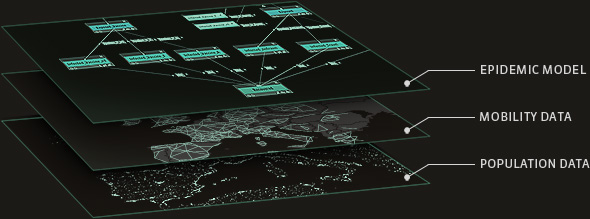Those that understand the idea of clustering and the Funnel of Opportunity versus some type of Sales Funnel manipulation will see the connection between infectious diseases and marketing. Several years back, I first ventured into the field of Biomimicry, Biomimicry for Design, Biofield for Sales, and found it very interesting. This past quarter I tried a simulation at Gleamviz: the Global Epidemic and Mobility Model to better understand the idea of how infectious diseases populate. Not so surprisingly the idea of how someone’s actual customer base populates is remarkably similar.

GLEAM produces realistic simulations of the global spread of infectious diseases. It integrates three layers: real-world data on the global population; real-world data on the mobility of this population; an individual based stochastic mathematical model of the infection dynamics.
The real-world population and mobility data are used to determine when and where people will interact and potentially transmit the infection. This data divides the world into a grid of small square cells. Satellite and census sources are used to calculate the population density in each of these cells, which are then clustered into subpopulations centered on their local transportation hub.
Using robust statistical methods, GLEAM executes the simulation in a sequence of time steps (representing full days). Within each population cluster, the spread of the infection among individuals is governed by the characteristics of the disease and the containment and mitigation responses specified in the epidemic model. Infection is transmitted between population clusters when people commute to work or school or travel longer distances on national and international flights.
When you build a Funnel of Opportunity, we integrate three layers; key customers, similar customers, and market segments to achieve our sales dynamics. Using a better and in turn a deeper understanding of customers and their markets we use qualitative and quantitative data to determine who will interact with our organization. The similarities discovered; determine what makes up the clusters created and adjacent clusters we should interact with. Remembering that even a disease does not interact without having someone that is susceptible to the disease, a willing participant you may say.
During this journey, I also discovered several other people that have done similar type work and have blogged about this subject matter. They describe the process in product development terms. Come to find out the ideas; innovation is generated in similar ways.
What Epidemiology Can Teach Us About the Infectiousness of Ideas by Mark Thompson, March 6, 2017
Mathematical Model Reveals the Patterns of How Innovations Arise (The work could lead to a new approach to the study of what is possible, and how it follows from what already exists) by Emerging Technology from the arXiv, January 13, 2017
What’s more, each innovation changes the landscape of future possibilities. So at every instant, the space of unexplored possibilities—the adjacent possible—is changing. “Though the creative power of the adjacent possible is widely appreciated at an anecdotal level, its importance in the scientific literature is, in our opinion, underestimated,” say Loreto and co.
I highly recommend reading both articles. The mystery, or at least an improvement on Wanamaker’s theory, on how to obtain customers are rapidly unfolding. The notion that we can create a customer through a better understanding of Adjacency may not be so far-fetched in the future. And most of it will come from a better understanding or nature, or maybe I should say human nature.

